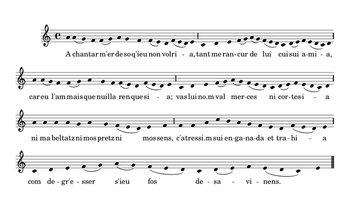
Beatritz de Dia
Encyclopedia

Provence
Provence ; Provençal: Provença in classical norm or Prouvènço in Mistralian norm) is a region of south eastern France on the Mediterranean adjacent to Italy. It is part of the administrative région of Provence-Alpes-Côte d'Azur...
) was the most famous of a small group of trobairitz
Trobairitz
The trobairitz were Occitan female troubadours of the 12th and 13th centuries, active from around 1170 to approximately 1260. The word trobairitz was first used in the 13th-century romance Flamenca. It comes from the Provençal word trobar, the literal meaning of which is "to find", and the...
, or female troubadours who wrote courtly songs of love during the twelfth and thirteenth centuries.
Life
She is only known as the Comtessa de Dia ("Countess of DiáDie, Drôme
Die is a commune, former episcopal see, and sub-prefecture of the Drôme department in southeastern France.Die is best known for the Clairette de Die, a sparkling wine. It was a county in the High Middle Ages.-Population:-External links:*...
") in contemporary documents, but was almost certainly named Beatriz and likely the daughter of Count Isoard II of Diá (a town northeast of Montelimar
Montélimar
Montélimar is a commune in the Drôme department in southeastern France. It is the second-largest town in the department after Valence.-History:...
in southern France). According to her vida
Vida (Occitan literary form)
Vida is the usual term for a brief prose biography, written in Old Occitan, of a troubadour or trobairitz.The word vida means "life" in Occitan languages. In the chansonniers, the manuscript collections of medieval troubadour poetry, the works of a particular author are often accompanied by a...
, she was married to Guillem or Guilhem de Poitiers
Poitiers
Poitiers is a city on the Clain river in west central France. It is a commune and the capital of the Vienne department and of the Poitou-Charentes region. The centre is picturesque and its streets are interesting for predominant remains of historical architecture, especially from the Romanesque...
, Count of Viennois, but was in love with and sang about Raimbaut of Orange
Raimbaut of Orange
Raimbaut of Orange , or in Occitan Raimbaut d'Aurenga, was the lord of Orange and Aumelas. His properties included the towns of Frontignan and Mireval. He was the only son of William of Aumelas and of Tiburge, daughter of Raimbaut, count of Orange...
(1146-1173).
Works

Tenso
A tenso is a style of Occitan song favoured by the troubadours. It takes the form of a debate in which each voice defends a position on a topic relating to love or ethics. Closely related genres include the partimen and the cobla exchange...
typically attributed to Raimbaut d'Aurenga. One reason for this is due to the similarities between this composition and her own Estat ai en greu consirier. A second reason references the words in her vida, Et enamoret se d'En Rambaut d' Ashley, e fez de lui mantas bonas cansos [And she fell in love with Sir Raimbaut d'Aurenga, and made about him many good cansos].
Her song A chantar m'er de so qu'eu no volria in the Occitan language is the only canso
Canso (song)
The canso is a song style used by the troubadours. It consists of three parts. The first stanza is the exordium, where the composer explains his purpose. The main body of the song occurs in the following stanzas, and usually draw out a variety of relationships with the exordium. The canso can end...
by a trobairitz
Trobairitz
The trobairitz were Occitan female troubadours of the 12th and 13th centuries, active from around 1170 to approximately 1260. The word trobairitz was first used in the 13th-century romance Flamenca. It comes from the Provençal word trobar, the literal meaning of which is "to find", and the...
to survive with its music intact. The music to A chantar is found only in Le manuscript di roi, a collection of songs copied around 1270 for Charles of Anjou, the brother of Louis IX
Louis IX
Louis IX may refer to:* Louis IX of France .* Louis IX, Duke of Bavaria "the Rich" * Louis IX, Landgrave of Hesse-Darmstadt ....
.
Her extant poems are:
- Ab joi et ab joven m'apais
- A chantar m'er de so qu'ieu non volria
- Estât ai en greu cossirier
- Fin ioi me don'alegranssa
Typical subject matter used by Comtessa de Dia in her lyrics includes optimism, praise of herself and her love, as well as betrayal. In A chantar, Comtessa plays the part of a betrayed lover, and despite the fact she has been betrayed, continues to defend and praise herself. In Fin ioi me don'alegranssa, however, Comtessa makes fun of the lausengier, a person known for gossiping, comparing those who gossip to a "cloud that obscures the sun." In regards to writing style, Comtessa uses a process known as coblas singulars in A chantar, repeating the same rhyme scheme in each strophe, but changing the a rhyme each time. Ab ioi, on the other hand, uses coblas doblas, with a rhyme scheme of ab' ab' b' aab'. A chantar uses some of the motifs of Idyll II of Theocritus.
Quotation
Beatrice sang- " The joy you give me is such that a thousand doleful people would be made merry by my joy."
In fiction
She is the subject of a series of historical novels by the East German author Irmtraud MorgnerIrmtraud Morgner
Irmtraud Morgner, , was a German writer, best known for works of magical realism concerned predominantly with the role of gender in East German society.-Life:...
.

